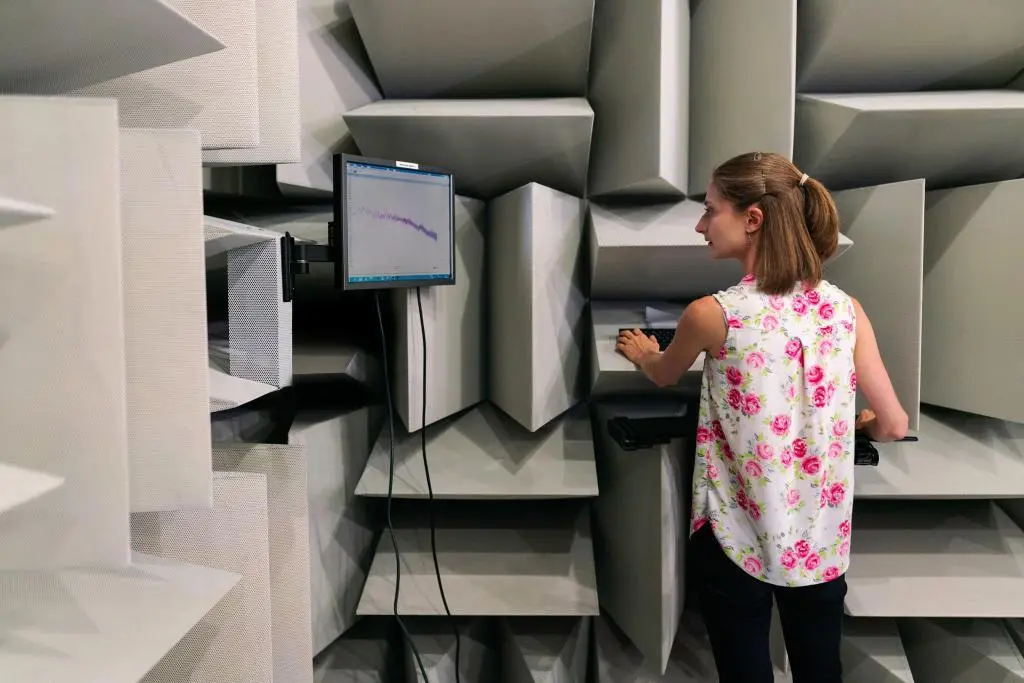In acoustics, absorption is simply use of “soft” material to reduce the intensity of sound waves.
Acoustic absorption is the process by which sound energy is taken in by a material, structure, or object when sound waves are encountered, rather than reflecting the energy. A portion of the absorbed energy is transformed into heat, and the other part is transmitted through the body that absorbs it. The energy that is transformed into heat is considered to be “lost.” When sound from a speaker hits the walls of a room, some of the energy is reflected, some is transmitted, and some is absorbed into the walls.

What is Absorption: Table of Contents
In the world of acoustics, the term “absorption” often floats around, sometimes leaving enthusiasts and novices alike scratching their heads. What does it truly mean? How does it impact our daily auditory experiences?
Let’s dive in and demystify this concept.
The Basic Definition of Absorption
Absorption, in the context of sound, refers to the phenomenon where a material, object, or structure takes in sound energy when it encounters sound waves. Instead of reflecting these waves back into the environment, the material transforms a portion of this energy into other forms, primarily heat.
This process reduces the overall sound energy in a space, leading to a decrease in echo and reverberation. In essence, sound absorption is the acoustic equivalent of a sponge soaking up water. It’s about capturing and dissipating sound waves to create clearer, more controlled acoustic environments.
Sound Waves & Oceans: The Absorption Analogy
To further grasp the concept of sound absorption, let’s draw a parallel with something more tangible: ocean waves.
Imagine standing on a beach, watching the waves crash against two distinct barriers – a solid concrete wall and a soft marshland.
When the waves hit the concrete wall, they are largely reflected back, causing splashes and maintaining most of their energy. This is similar to how sound waves behave when they encounter hard, non-absorptive surfaces; they bounce back, leading to echoes and increased sound levels.
On the other hand, when the waves reach the marshland, they are absorbed, losing their energy as they traverse through the soft, malleable ground. The marshland, with its intricate network of plants and mud, dissipates the wave energy, preventing it from reflecting back into the ocean.
Similarly, absorptive materials in acoustics, like foam panels or thick curtains, capture and reduce sound energy, minimizing reflections and creating a more muted auditory environment.
In both scenarios, whether it’s the vast ocean or the intricate world of sound, absorption plays a crucial role in determining how energy waves interact with their surroundings. By understanding this concept, we can better design and optimize our spaces for the desired acoustic experience.

The Science Behind Sound Absorption
The world of sound is a fascinating realm, where waves of energy travel, interact, and transform in a lot of ways. At the heart of this sonic dance lies the concept of absorption, a phenomenon that plays a pivotal role in shaping our auditory experiences. But what really happens when sound waves meet different materials? How does this energy transition from audible waves to unnoticeable heat? Let’s delve into the captivating science behind sound absorption.
From Sound to Heat: The Energy Shift
Every sound we hear, from the gentle hum of a refrigerator to the roaring applause in a concert hall is a manifestation of energy. When these sound waves encounter surfaces, not all of them bounce back or pass through. Some of this energy is absorbed by the material it meets. This is where the magic of absorption comes into play.
As sound waves penetrate absorptive materials, they cause the particles within those materials to vibrate. These vibrations generate friction, and this friction, in turn, produces heat. It’s a subtle and often unnoticed transformation, but it’s happening all around us. The once-audible sound energy metamorphoses into a form of thermal energy, reducing the overall sound intensity in the process. This is why spaces with ample absorptive materials feel quieter and more controlled, as a significant portion of the sound energy is being converted into heat.
Sound Waves: A Voyage Through Materials
Sound waves, much like travelers, embark on unique journeys based on the terrains they traverse. The interaction between sound waves and materials is a tale of reflection, transmission, and, of course, absorption.
When sound waves meet hard, non-porous surfaces like concrete or glass, most of the energy is reflected back, leading to echoes and increased sound levels. These materials offer little resistance, causing the sound waves to bounce off them, much like a ball rebounding off a wall.
Conversely, soft, porous materials like foam, fabric, or even certain types of wood, act as welcoming hosts to these traveling sound waves. They allow the waves to penetrate their structure, where the energy gets trapped, vibrates, and eventually dissipates as heat. The depth, density, and texture of these materials determine the extent of absorption, with thicker and more porous materials generally offering higher levels of sound absorption.

The Role of Sound Absorption in Room Acoustics
In the realm of room acoustics, every detail matters. From the size and shape of the space to the materials used in its construction, each element plays a part in determining how sound behaves within that environment. Among these factors, absorption stands out as a key player, wielding the power to transform a room’s acoustic character. Let’s delve into the indispensable role of sound absorption in shaping the acoustics of a room.
Battling Echoes and Reverberations
We’ve all been in spaces where our words seem to bounce around endlessly, creating a confusing maze of sound. These are echoes and reverberations, the notorious culprits that can turn a beautifully designed room into an acoustic nightmare. But here’s where the magic of absorption comes into play.
Echoes are created when sound waves reflect off hard surfaces and return to the listener’s ears, causing a delayed repetition of the original sound. Reverberation, on the other hand, is the persistence of sound in a space even after the original source has stopped, due to multiple reflections off walls, ceilings, and floors. Both these phenomena can muddy the clarity of sound, making communication challenging and music listening less enjoyable.
Enter sound absorption. By introducing absorptive materials into a space, we can significantly reduce these unwanted sound reflections. These materials soak up the sound energy, preventing it from bouncing back and forth. The result? A room where sound behaves, where conversations are clear, and where every musical note is heard without the interference of persistent echoes or reverberations.
Enhancing Speech and Sound Quality
Beyond battling echoes and reverberations, absorption plays a pivotal role in enhancing the overall quality of sound within a room. Whether it’s a classroom, a conference hall, or a home theater, the clarity of speech and sound is paramount.
Absorptive materials help in filtering out background noises and reducing sound reflections, ensuring that the primary sound source, be it a teacher’s lecture or a singer’s voice, reaches the listener’s ears with minimal distortion. This not only improves speech intelligibility but also enriches the overall auditory experience. For instance, in a recording studio, absorption ensures that the artist’s voice is captured without the interference of unwanted noises or reflections, preserving the purity and authenticity of the sound.
A Deep Dive into Absorption Coefficients
The absorption coefficient is a numerical value that represents a material’s ability to absorb sound energy. Ranging between 0 (perfect reflection) and 1 (perfect absorption), this coefficient provides a clear picture of how a material will behave when confronted with sound waves. A higher coefficient indicates that the material is highly absorptive, while a lower value suggests that it will reflect more sound.
But here’s the catch: absorption is not consistent across all frequencies. A material might be highly absorptive at lower frequencies but less effective at higher ones. This is where the concept of frequency bands comes into play. By examining absorption coefficients across various frequency bands, we can gain a holistic understanding of a material’s acoustic properties.
Absorption Coefficients for Different Materials
| MATERIALS | 125 hZ | 250 hZ | 500 hZ | 1000 hZ | 2000 hZ | 4000 hZ |
|---|---|---|---|---|---|---|
| Brick | .03 | .03 | .03 | .04 | .05 | .07 |
| Carpet on concrete | .02 | .06 | .14 | .37 | .60 | .65 |
| Carpet with Heavy Pad | .08 | .24 | .57 | .69 | .71 | .73 |
| Carpet with Impermeable Layer | .08 | .27 | .39 | .34 | .48 | .63 |
| Concrete block (unpainted) | .36 | .44 | .31 | .29 | .39 | .25 |
| Concrete block (painted) | .10 | .05 | .06 | .07 | .09 | .08 |
| Light fabric | .03 | .04 | .11 | .17 | .24 | .35 |
| Medium fabric | .07 | .31 | .49 | .75 | .70 | .60 |
| Heavy fabric | .14 | .35 | .55 | .72 | .70 | .65 |
| Concrete, marble or glazed tile | .01 | .01 | .015 | .02 | .02 | .02 |
| Wood | .15 | .11 | .10 | .07 | .06 | .07 |
| Heavy Glass | .18 | .06 | .04 | .03 | .02 | .02 |
| Glass | .35 | .25 | .18 | .12 | .07 | .04 |
| Gypsum Board | .29 | .10 | .05 | .04 | .07 | .09 |
| Plaster | .013 | .015 | .02 | .03 | .04 | .05 |
| Water surface | .008 | .008 | .013 | .015 | .020 | .025 |
By referring to such tables, architects, interior designers, and acoustic experts can make informed decisions about which materials to use in a given space. Whether it’s optimizing a recording studio or enhancing the acoustics of a living room, understanding absorption coefficients is key to achieving the desired sound environment.
Absorption coefficients can be measured using a reverberation room, which is the opposite of an anechoic chamber.
What is Reverberation Room
Reverberation rooms, as the name suggests, are spaces intentionally designed to create reflections and reverberations. Unlike everyday rooms where absorption is often desired to reduce echoes, these rooms aim to maximize them. The walls, ceiling, and floor are typically made of hard, reflective materials, ensuring that sound waves bounce around freely, with minimal absorption.
But why would one want a room filled with echoes? The answer lies in its purpose. Reverberation rooms are crucial for testing the sound power levels of noise sources, such as machinery, appliances, or even musical instruments. By measuring the sound energy in a controlled reverberant environment, researchers can obtain accurate data on how loud a source truly is, devoid of external interferences.
Moreover, these rooms play a significant role in testing the absorption properties of materials. By introducing a material into the room and observing the changes in reverberation times, one can gauge the material’s absorptive capabilities.

What is Anechoic Chamber
In stark contrast to the lively echoes of reverberation rooms, anechoic chambers are temples of silence. The term “anechoic” translates to “without echo,” and these chambers are designed to absorb as much sound as possible, offering an almost entirely reflection-free environment.
Anechoic chambers are lined with sound-absorbing materials, often in the form of wedges or pyramids, which trap and dissipate sound waves, preventing them from reflecting back into the room. The result is an eerily quiet space, where even the faintest sounds become distinctly audible.
The primary purpose of an anechoic chamber is to conduct precise acoustic measurements in a controlled environment. Whether it’s testing the performance of a new microphone, studying the intricate sounds of a musical instrument, or researching the nuances of human speech, these chambers provide an isolated space free from external noise and reflections.
Sound Absorption or Sound Transmission: Which is Which?
Sound absorption and sound transmission are terms and concepts often intertwine, leading to potential confusion. While they might sound similar and are indeed related, they serve distinct roles in the world of sound. Let’s delve deeper to untangle these concepts and highlight their unique characteristics.
At its core, sound absorption deals with how materials or objects take in sound energy, reducing its reflection within a particular space. When sound waves encounter an absorptive material, a portion of their energy is captured and transformed, primarily into heat. This process helps in controlling echoes and reverberations, ensuring a clearer and more defined auditory experience. Think of sound absorption as a sponge soaking up water; it’s all about trapping and dissipating the energy.
On the flip side, sound transmission revolves around how sound waves travel through a material or medium. Instead of capturing the energy, materials involved in sound transmission allow the sound waves to pass through them, often leading to the sound being heard on the other side. The effectiveness of a material in blocking or allowing sound transmission is measured by its Sound Transmission Class (STC). While absorption focuses on controlling the sound within a space, sound transmission is all about managing the sound between spaces.
For instance, in a recording studio, while absorption ensures that the artist’s voice is captured without the interference of unwanted noises or reflections within the room, sound transmission considerations ensure that external noises, like traffic or conversations from adjacent rooms, don’t seep into the recording space.
Sound Absorption in Action: Real-world Applications
The magic of sound absorption isn’t just confined to technical textbooks or specialized acoustic labs. Its influence is woven into the fabric of our daily lives, subtly enhancing our auditory experiences in a multitude of settings. From the hallowed halls of churches to the lively atmosphere of pubs, the principles of sound absorption are hard at work. Let’s traverse through various spaces to discover how they utilize absorption to optimize their acoustics.
From Churches to Pubs: A Sonic Journey
Churches and Cathedrals: Majestic structures with towering ceilings and expansive interiors, churches naturally reverberate with echoes. While this ambiance adds depth to choral hymns, it can cloud spoken words during sermons. To counteract this, many religious spaces incorporate absorptive elements like padded pews, heavy curtains, or custom acoustic panels, ensuring clarity and resonance coexist harmoniously.
Restaurants and Cafés: The delightful cacophony of clinking cutlery, animated conversations, and the sizzle from the kitchen can sometimes overwhelm diners. By integrating absorptive materials such as fabric wall panels, plush seating, or carpeting, these eateries can dampen excessive noise, fostering a cozy dining ambiance.
Salons and Barber Shops: Amidst the buzz of hairdryers, the rhythmic snip of scissors, and chit-chat, salons are a hive of sound. Soft chairs, fabric dividers, and even product-laden shelves can serve as absorptive elements, ensuring clients can unwind in an acoustically pleasant environment.
Recording Studios: The birthplace of music and podcasts, recording studios demand pristine acoustics. Walls lined with high-grade absorptive foam, floating floors, and bass traps ensure that every note and word is captured with utmost clarity, free from unwanted echoes or external noises.
Concert Halls and Theatre Halls: These venues are designed to amplify performances, be it a symphony or a play. However, unchecked reverberations can muddy the experience. Through strategic placement of absorptive materials, tiered seating designs, and specialized acoustic treatments, these halls ensure audiences receive clear and immersive sound.
Wedding Venues: The vows, the music, the laughter – every sound at a wedding is precious. Venues often use draperies, carpeted aisles, and even temporary acoustic panels to balance the sound, ensuring that every guest, whether seated up front or at the back, can partake in the joyous moments.
Pubs: The heart of nightlife, pubs are abuzz with music, conversations, and cheer. Wooden interiors, upholstered seating, and even decorative wall hangings play a dual role: adding to the decor and acting as absorptive surfaces. This ensures that while the energy remains high, the sound levels are comfortable and conversations flow smoothly.
Expert Tips and Essential Reminders
In the realm of acoustics, knowledge is power. Understanding the nuances and intricacies of sound can make all the difference in crafting the perfect auditory environment. Whether you’re a budding audio engineer, a seasoned music producer, or simply someone keen on improving the sound quality of your space, there are certain principles and pointers that can guide you on your acoustic journey. Let’s delve into some expert tips and essential reminders that can elevate your understanding of absorption and its applications.
Sound Absorption vs. Soundproofing: Know the Difference
One of the most common misconceptions in acoustics is conflating sound absorption with soundproofing. While they might seem similar at a glance, they serve distinct purposes:
- Sound Absorption: This is all about improving the acoustic quality within a space. Absorptive materials, like acoustic foam or fabric panels, capture and dissipate sound waves, reducing echoes and reverberations. Think of it as controlling the behavior of sound within a room, ensuring clarity and reducing noise buildup.
- Soundproofing: On the other hand, soundproofing is about preventing sound from either entering or leaving a space. It’s the art of isolation. Materials used for soundproofing, such as mass-loaded vinyl or resilient channels, act as barriers, blocking sound transmission between spaces.
Frequencies Matter
Sound isn’t monolithic. It’s a spectrum of frequencies, each with its unique characteristics. When it comes to sound absorption, it’s imperative to be frequency-aware. Different materials have varying absorption coefficients across the frequency spectrum. For instance, thick draperies might be effective at absorbing lower frequencies but might struggle with higher-pitched sounds.
Being attuned to the specific frequencies you’re dealing with can guide your choice of absorptive materials. If you’re setting up a home theater, you might prioritize materials that excel at absorbing low-frequency rumbles. Conversely, a vocal recording booth might benefit from materials that target mid to high frequencies.
Moreover, understanding the frequency response of materials can help in layering different absorptive elements, creating a balanced acoustic environment that caters to a wide range of frequencies.
In conclusion, the world of sound absorption is both an art and a science. By equipping yourself with the right knowledge, understanding the nuances of materials, and being frequency-aware, you can navigate the acoustic landscape with confidence and finesse. Whether you’re aiming for the perfect studio sound or simply a peaceful living space, these expert tips and reminders will serve as your compass.

